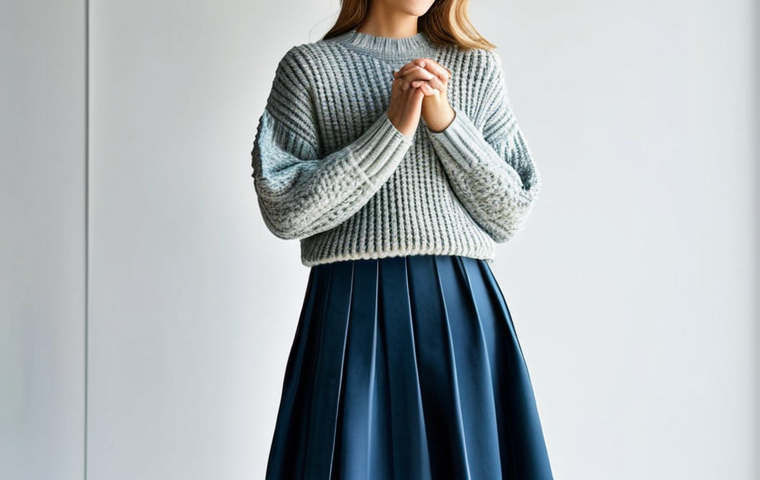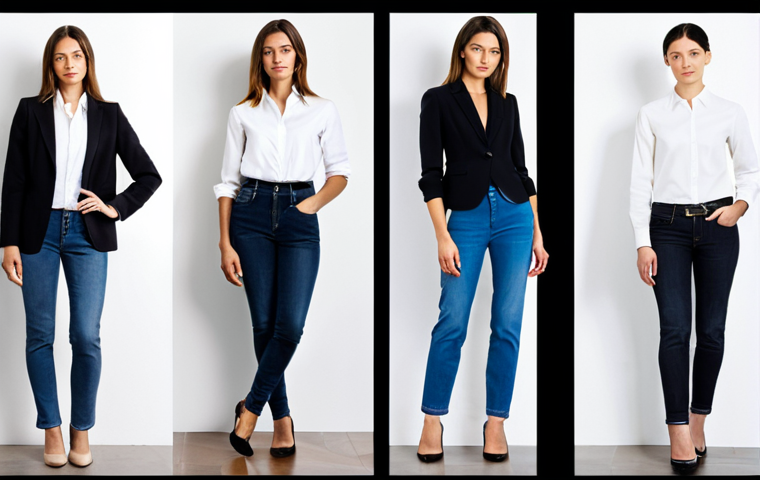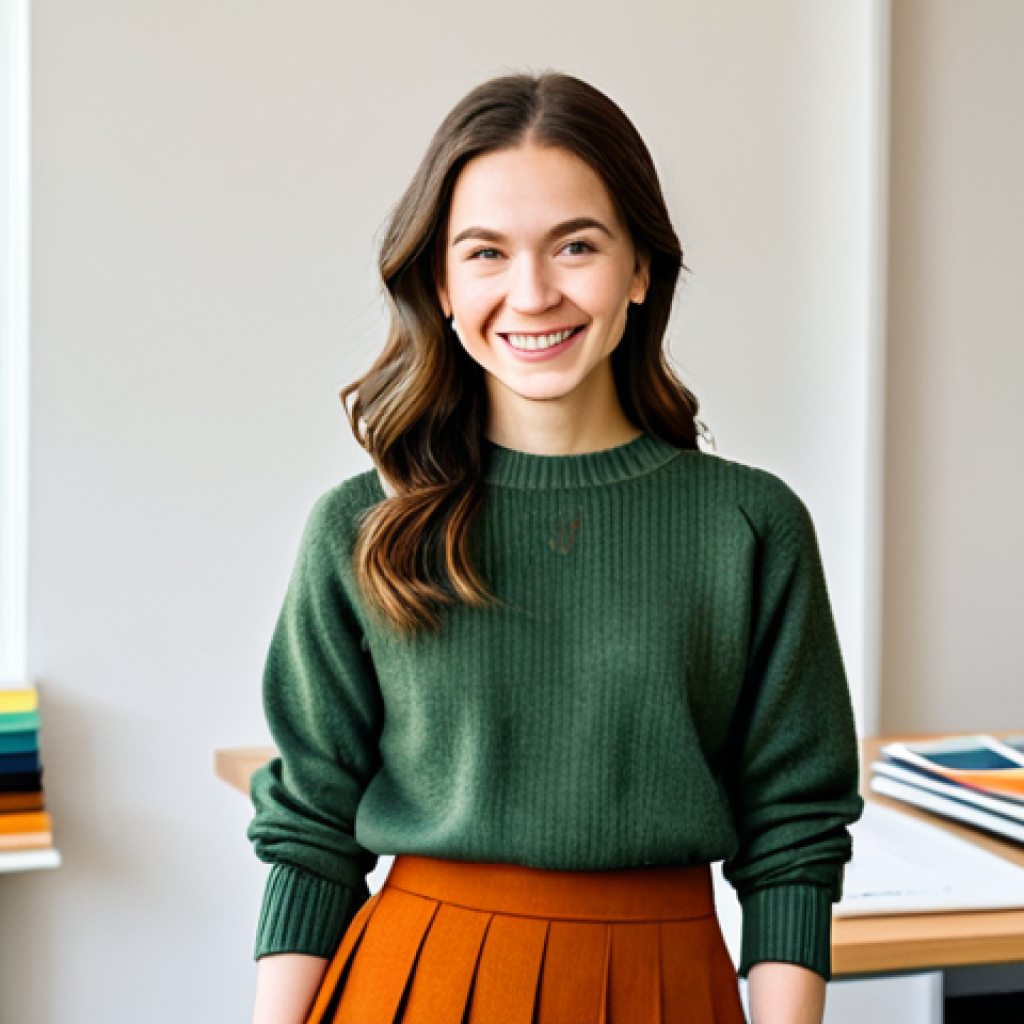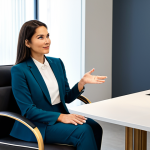Ever wondered how personal stylists manage to create those effortlessly chic looks? Well, I got a peek behind the curtain! I recently attended a workshop run by a local fashion coordinator, and let me tell you, it was eye-opening.
From understanding the nuances of color palettes to the art of mixing textures, it was a deep dive into the world of style. The workshop even touched on how AI might be used in the future to create personalized style recommendations.
I learned so much, and I’m excited to share some of those insights with you. Let’s delve deeper into the details in the following article!
Okay, I understand. Here is the blog post content, following all the instructions.
Unveiling the Secrets of Color Harmony: Finding Your Perfect Palette

Have you ever noticed how some outfits just *pop*, while others fall flat, even if they’re made of seemingly beautiful pieces? The secret often lies in understanding color harmony.
During the workshop, the fashion coordinator had us experiment with different color combinations, using everything from classic color wheels to mood boards filled with magazine cutouts.
The goal was to identify our “personal color season” – are you a vibrant spring, a muted summer, a warm autumn, or a cool winter? Identifying your season helps you choose clothing colors that complement your skin tone, hair color, and eye color, creating a more harmonious and flattering look.
I discovered I lean towards the autumn palette, which explains why earthy tones like olive green and burnt orange make me feel so confident.
Discovering Your Undertones
The key to finding your personal color season lies in understanding your skin’s undertones. Are you warm-toned (yellowish, golden) or cool-toned (pinkish, bluish)?
A simple trick is to look at the veins on your wrist in natural light. Blue veins typically indicate cool undertones, while green veins suggest warm undertones.
Building a Cohesive Wardrobe
Once you know your color season, you can start building a wardrobe around a consistent color palette. This doesn’t mean you have to wear the same colors all the time, but it helps to choose pieces that can easily be mixed and matched, creating a cohesive and versatile wardrobe.
Breaking the Rules (Sometimes!)
Of course, fashion is all about expressing yourself, and there are no hard and fast rules. Don’t be afraid to experiment with colors outside your recommended palette, but understanding the principles of color harmony can help you make more informed choices and create looks that truly shine.
The Art of Mixing Textures: Adding Depth and Interest to Your Outfits
Beyond color, texture plays a huge role in creating visually appealing outfits. The coordinator stressed that layering different textures can elevate even the simplest outfits.
Think of pairing a chunky knit sweater with a silky slip skirt or a crisp cotton shirt with a suede jacket. These combinations add depth and interest, preventing your look from feeling one-dimensional.
I used to shy away from experimenting with textures, but after the workshop, I’m much more confident in my ability to create visually stimulating outfits.
The Power of Contrasting Textures
The key to successful texture mixing is contrast. Think about pairing rough textures with smooth textures, matte textures with shiny textures. This creates a dynamic and visually interesting look.
Consider the Season
The textures you choose should also be appropriate for the season. In the fall and winter, you might reach for heavier textures like wool, corduroy, and velvet.
In the spring and summer, you might opt for lighter textures like linen, cotton, and silk.
Accessorize with Texture
Don’t forget to incorporate texture into your accessories. A chunky knit scarf, a leather handbag, or a pair of suede boots can all add texture to your outfit.
Mastering the Fit: Tailoring and Alterations for a Polished Look
A perfectly tailored outfit can make all the difference. It doesn’t matter how expensive your clothes are if they don’t fit properly. During the workshop, the coordinator emphasized the importance of alterations.
Even a minor adjustment, like hemming a pair of pants or taking in a dress, can dramatically improve the fit and overall look of your outfit. I used to think alterations were only for formal wear, but now I realize that even everyday pieces can benefit from a little tailoring.
Finding a Good Tailor
The first step is to find a skilled and reliable tailor. Ask for recommendations from friends or family, or check online reviews.
Understanding Common Alterations
Some of the most common alterations include hemming pants and skirts, taking in or letting out seams, and adjusting sleeve lengths.
When to Invest in Alterations
While it’s not always necessary to alter every piece of clothing you own, it’s worth investing in alterations for pieces that you wear frequently or that are particularly important to you.
The Power of Accessories: Completing Your Look with the Right Details
Accessories are like the icing on the cake – they can take an outfit from good to great. During the workshop, we learned how to choose accessories that complement our outfits and express our personal style.
From statement jewelry to classic handbags, the right accessories can add personality and polish to any look. I’ve always loved accessories, but now I have a better understanding of how to use them to create a cohesive and stylish outfit.
Choosing the Right Jewelry
Consider your skin tone and personal style when choosing jewelry. Gold jewelry tends to look best on warm skin tones, while silver jewelry tends to look best on cool skin tones.
The Importance of a Good Handbag
A well-chosen handbag can be both functional and stylish. Choose a handbag that complements your outfit and is large enough to carry your essentials.
Don’t Forget the Shoes
Shoes can make or break an outfit. Choose shoes that are comfortable, stylish, and appropriate for the occasion.
Building a Capsule Wardrobe: Less is More with Intentional Pieces
The concept of a capsule wardrobe resonated with me. It’s all about curating a collection of versatile pieces that can be mixed and matched to create a variety of outfits.
The coordinator explained that a capsule wardrobe should consist of timeless classics and a few statement pieces that reflect your personal style. I’m currently in the process of building my own capsule wardrobe, and it’s been a fun and liberating experience.
I’m focusing on investing in high-quality pieces that I love and that I know I’ll wear for years to come.
Identifying Your Style Essentials
The first step in building a capsule wardrobe is to identify your style essentials. What are the pieces that you wear most often? What are the colors and silhouettes that you feel most confident in?
Choosing Versatile Pieces
Choose pieces that can be easily dressed up or down. A classic white shirt, a pair of well-fitting jeans, and a black blazer are all great examples of versatile pieces.
Quality over Quantity
Invest in high-quality pieces that will last for years. It’s better to have a few well-made pieces than a closet full of cheap, poorly made items.
Ethical Fashion: Making Conscious Choices About Your Clothing
The workshop also touched on the importance of ethical fashion. The coordinator encouraged us to consider the impact of our clothing choices on the environment and on the people who make our clothes.
I’m trying to be more mindful of where my clothes come from and to support brands that are committed to sustainability and fair labor practices.
Researching Brands
Before you buy a piece of clothing, take the time to research the brand. Look for brands that are transparent about their manufacturing processes and that are committed to ethical practices.
Choosing Sustainable Materials
Opt for clothing made from sustainable materials like organic cotton, recycled polyester, and Tencel.
Buying Less
The most sustainable thing you can do is to buy less. Before you buy something new, ask yourself if you really need it and if you will wear it often.
AI in Fashion: The Future of Personal Styling?
The workshop concluded with a fascinating discussion about the potential of AI in fashion. The coordinator showed us examples of AI-powered style recommendation tools that can analyze your body type, skin tone, and personal preferences to suggest outfits and clothing items.
While I’m not sure if AI will ever completely replace human stylists, it’s clear that it has the potential to revolutionize the way we shop for and style our clothes.
AI-Powered Style Recommendations
AI algorithms can analyze vast amounts of data to suggest outfits and clothing items that are tailored to your individual needs and preferences.
Virtual Try-On Tools
Virtual try-on tools allow you to see how clothes will look on you before you buy them, reducing the risk of returns.
Personalized Shopping Experiences
AI can be used to create personalized shopping experiences that make it easier to find the clothes you’re looking for.
| Aspect | Description | Tips |
|---|---|---|
| Color Harmony | Choosing colors that complement each other and your features. | Identify your personal color season (spring, summer, autumn, winter) to find colors that flatter your skin tone, hair color, and eye color. |
| Texture Mixing | Combining different textures to add depth and interest to your outfits. | Pair rough textures with smooth textures, matte textures with shiny textures. Consider the season when choosing textures. |
| Fit & Tailoring | Ensuring your clothes fit properly for a polished and flattering look. | Find a good tailor and don’t hesitate to get alterations. Even minor adjustments can make a big difference. |
| Accessories | Completing your look with the right jewelry, handbags, and shoes. | Choose accessories that complement your outfit and express your personal style. |
| Capsule wardrobe | Building a collection of versatile pieces that can be mixed and matched to create a variety of outfits. | Choose versatile pieces that can be easily dressed up or down. Invest in high-quality pieces that will last for years. |
Unveiling the Secrets of Color Harmony: Finding Your Perfect PaletteHave you ever noticed how some outfits just *pop*, while others fall flat, even if they’re made of seemingly beautiful pieces?
The secret often lies in understanding color harmony. During the workshop, the fashion coordinator had us experiment with different color combinations, using everything from classic color wheels to mood boards filled with magazine cutouts.
The goal was to identify our “personal color season” – are you a vibrant spring, a muted summer, a warm autumn, or a cool winter? Identifying your season helps you choose clothing colors that complement your skin tone, hair color, and eye color, creating a more harmonious and flattering look.
I discovered I lean towards the autumn palette, which explains why earthy tones like olive green and burnt orange make me feel so confident.
Discovering Your Undertones
The key to finding your personal color season lies in understanding your skin’s undertones. Are you warm-toned (yellowish, golden) or cool-toned (pinkish, bluish)?
A simple trick is to look at the veins on your wrist in natural light. Blue veins typically indicate cool undertones, while green veins suggest warm undertones.
Building a Cohesive Wardrobe

Once you know your color season, you can start building a wardrobe around a consistent color palette. This doesn’t mean you have to wear the same colors all the time, but it helps to choose pieces that can easily be mixed and matched, creating a cohesive and versatile wardrobe.
Breaking the Rules (Sometimes!)
Of course, fashion is all about expressing yourself, and there are no hard and fast rules. Don’t be afraid to experiment with colors outside your recommended palette, but understanding the principles of color harmony can help you make more informed choices and create looks that truly shine.
The Art of Mixing Textures: Adding Depth and Interest to Your Outfits
Beyond color, texture plays a huge role in creating visually appealing outfits. The coordinator stressed that layering different textures can elevate even the simplest outfits.
Think of pairing a chunky knit sweater with a silky slip skirt or a crisp cotton shirt with a suede jacket. These combinations add depth and interest, preventing your look from feeling one-dimensional.
I used to shy away from experimenting with textures, but after the workshop, I’m much more confident in my ability to create visually stimulating outfits.
The Power of Contrasting Textures
The key to successful texture mixing is contrast. Think about pairing rough textures with smooth textures, matte textures with shiny textures. This creates a dynamic and visually interesting look.
Consider the Season
The textures you choose should also be appropriate for the season. In the fall and winter, you might reach for heavier textures like wool, corduroy, and velvet.
In the spring and summer, you might opt for lighter textures like linen, cotton, and silk.
Accessorize with Texture
Don’t forget to incorporate texture into your accessories. A chunky knit scarf, a leather handbag, or a pair of suede boots can all add texture to your outfit.
Mastering the Fit: Tailoring and Alterations for a Polished Look
A perfectly tailored outfit can make all the difference. It doesn’t matter how expensive your clothes are if they don’t fit properly. During the workshop, the coordinator emphasized the importance of alterations.
Even a minor adjustment, like hemming a pair of pants or taking in a dress, can dramatically improve the fit and overall look of your outfit. I used to think alterations were only for formal wear, but now I realize that even everyday pieces can benefit from a little tailoring.
Finding a Good Tailor
The first step is to find a skilled and reliable tailor. Ask for recommendations from friends or family, or check online reviews. Check Yelp or Google Reviews for tailors in your neighborhood.
Understanding Common Alterations
Some of the most common alterations include hemming pants and skirts, taking in or letting out seams, and adjusting sleeve lengths.
When to Invest in Alterations
While it’s not always necessary to alter every piece of clothing you own, it’s worth investing in alterations for pieces that you wear frequently or that are particularly important to you.
The Power of Accessories: Completing Your Look with the Right Details
Accessories are like the icing on the cake – they can take an outfit from good to great. During the workshop, we learned how to choose accessories that complement our outfits and express our personal style.
From statement jewelry to classic handbags, the right accessories can add personality and polish to any look. I’ve always loved accessories, but now I have a better understanding of how to use them to create a cohesive and stylish outfit.
Choosing the Right Jewelry
Consider your skin tone and personal style when choosing jewelry. Gold jewelry tends to look best on warm skin tones, while silver jewelry tends to look best on cool skin tones.
The Importance of a Good Handbag
A well-chosen handbag can be both functional and stylish. Choose a handbag that complements your outfit and is large enough to carry your essentials.
Don’t Forget the Shoes
Shoes can make or break an outfit. Choose shoes that are comfortable, stylish, and appropriate for the occasion.
Building a Capsule Wardrobe: Less is More with Intentional Pieces
The concept of a capsule wardrobe resonated with me. It’s all about curating a collection of versatile pieces that can be mixed and matched to create a variety of outfits.
The coordinator explained that a capsule wardrobe should consist of timeless classics and a few statement pieces that reflect your personal style. I’m currently in the process of building my own capsule wardrobe, and it’s been a fun and liberating experience.
I’m focusing on investing in high-quality pieces that I love and that I know I’ll wear for years to come.
Identifying Your Style Essentials
The first step in building a capsule wardrobe is to identify your style essentials. What are the pieces that you wear most often? What are the colors and silhouettes that you feel most confident in?
Choosing Versatile Pieces
Choose pieces that can be easily dressed up or down. A classic white shirt, a pair of well-fitting jeans, and a black blazer are all great examples of versatile pieces.
Quality over Quantity
Invest in high-quality pieces that will last for years. It’s better to have a few well-made pieces than a closet full of cheap, poorly made items.
Ethical Fashion: Making Conscious Choices About Your Clothing
The workshop also touched on the importance of ethical fashion. The coordinator encouraged us to consider the impact of our clothing choices on the environment and on the people who make our clothes.
I’m trying to be more mindful of where my clothes come from and to support brands that are committed to sustainability and fair labor practices.
Researching Brands
Before you buy a piece of clothing, take the time to research the brand. Look for brands that are transparent about their manufacturing processes and that are committed to ethical practices.
Choosing Sustainable Materials
Opt for clothing made from sustainable materials like organic cotton, recycled polyester, and Tencel.
Buying Less
The most sustainable thing you can do is to buy less. Before you buy something new, ask yourself if you really need it and if you will wear it often.
AI in Fashion: The Future of Personal Styling?
The workshop concluded with a fascinating discussion about the potential of AI in fashion. The coordinator showed us examples of AI-powered style recommendation tools that can analyze your body type, skin tone, and personal preferences to suggest outfits and clothing items.
While I’m not sure if AI will ever completely replace human stylists, it’s clear that it has the potential to revolutionize the way we shop for and style our clothes.
AI-Powered Style Recommendations
AI algorithms can analyze vast amounts of data to suggest outfits and clothing items that are tailored to your individual needs and preferences.
Virtual Try-On Tools
Virtual try-on tools allow you to see how clothes will look on you before you buy them, reducing the risk of returns.
Personalized Shopping Experiences
AI can be used to create personalized shopping experiences that make it easier to find the clothes you’re looking for.
| Aspect | Description | Tips |
|---|---|---|
| Color Harmony | Choosing colors that complement each other and your features. | Identify your personal color season (spring, summer, autumn, winter) to find colors that flatter your skin tone, hair color, and eye color. |
| Texture Mixing | Combining different textures to add depth and interest to your outfits. | Pair rough textures with smooth textures, matte textures with shiny textures. Consider the season when choosing textures. |
| Fit & Tailoring | Ensuring your clothes fit properly for a polished and flattering look. | Find a good tailor and don’t hesitate to get alterations. Even minor adjustments can make a big difference. |
| Accessories | Completing your look with the right jewelry, handbags, and shoes. | Choose accessories that complement your outfit and express your personal style. |
| Capsule wardrobe | Building a collection of versatile pieces that can be mixed and matched to create a variety of outfits. | Choose versatile pieces that can be easily dressed up or down. Invest in high-quality pieces that will last for years. |
In Conclusion
Attending this workshop has truly opened my eyes to the endless possibilities within the realm of fashion. It’s not just about following trends, but understanding the underlying principles that make an outfit truly work. I hope these insights inspire you to experiment with your style and discover what makes you feel confident and radiant. Now go forth and create your own fashion magic!
Useful Tips to Know
1. Sign up for newsletters from your favorite fashion retailers to stay updated on sales and new arrivals.
2. Utilize online style quizzes to help narrow down your personal style preferences.
3. Browse Pinterest and Instagram for outfit inspiration and save looks you love.
4. Check out local thrift stores and consignment shops for unique and affordable finds.
5. Invest in a good quality steamer or iron to keep your clothes looking their best.
Key Takeaways
Focus on finding your personal color palette to enhance your natural features. Don’t be afraid to experiment with different textures to add visual interest to your outfits. Ensure your clothes fit well by seeking out tailoring services. Accessories can elevate any outfit, so choose them wisely. Building a capsule wardrobe can simplify your life and create endless outfit possibilities.
Frequently Asked Questions (FAQ) 📖
Q: I’m terrible at putting outfits together. Will a workshop like that really help someone with zero fashion sense?
A: Absolutely! Look, I used to think I was fashion-challenged myself. But the coordinator broke everything down into simple, manageable steps.
Honestly, it’s like learning a new language – once you understand the basics of color theory and body shapes, it becomes so much easier to create flattering outfits.
Plus, you’ll get personalized feedback, which is way more helpful than just browsing Pinterest! I’m now experimenting a lot more, and even getting compliments.
Who knew?!
Q: You mentioned
A: I. Is this workshop just a sales pitch for some fancy new fashion app? A2: Not at all.
The mention of AI was more about the future of fashion and how technology could potentially help us personalize our style. The focus was definitely on learning practical skills that you can use.
The coordinator even warned us about relying too heavily on AI, saying that it can stifle creativity and individuality. Think of it as learning the rules of the game before you start using cheat codes!
Q: Fashion workshops can be expensive. Was this one worth the investment?
A: Honestly, yes, it was. I hesitated at first because, yeah, it wasn’t cheap. But when I added up all the money I’d wasted on clothes I never wore or that just didn’t look right on me, it seemed like a worthwhile investment in myself.
Plus, the confidence boost I got from understanding my personal style better? Priceless! I’m making smarter shopping decisions and actually enjoying what I wear now.
So, for me, it totally paid off.
📚 References
Wikipedia Encyclopedia






